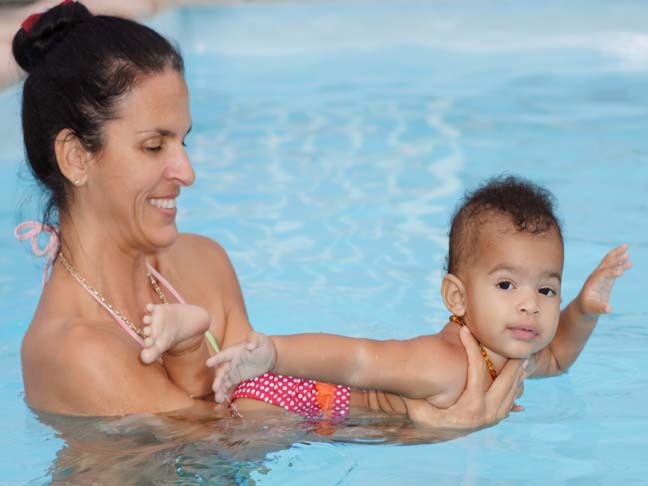It’s a great way to build the bond of love trust that parents and children share, and it allows babies the freedom to move in a completely different way than they normally can. The exercise helps their developing muscles and improves their flexibility and stamina.
The first time you take your baby swimming, you might worry they won’t like it, but remember babies have a natural fondness for water, having spent nine months in the amniotic fluid of the womb. Taking a baby swimming on a regular basis helps that baby develop into a child who is confident in the water.
The earlier you start swimming with your baby the better. It is generally advised to have your six week postnatal check up with your doctor, but as long as the doctor sees no problems, you can start swimming right away after that. You should check with your local pool as some insist on your baby having had their eight week vaccinations before swimming (though the NHS advises there are no medical reasons for this).
The first thing you should do is contact your local pool and check they have a small pool suitably warm enough for babies (at least 32 degrees for babies under six months). Ask them if they have a place to store your buggy safely, and ask when the pool is quietest so you can take your baby at a time when you have plenty of space. You could also ask if they have any sessions especially for babies. Many pools offer sessions for parents and babies with songs and different activities aimed at introducing babies to water in a fun way, with an instructor on hand who can offer advice.
If you don’t already have one, buy a swimming costume or wetsuit for your baby, and some swim nappies. Some costumes come with washable swim nappies but you can buy disposable ones. The pool will probably sell things like costumes and swim nappies, but at a much higher price so it’s best to buy them before you go. When you pack your bag, as well as your own swimming things, remember to take a spare swim nappy just in case, normal nappies and wipes, a portable changing mat, a hooded towel and any favourite bath toys for familiarity.
The first time you go into the water with your baby, keep her close to you, smiling and talking or singing to her all the time. Try to keep your baby’s shoulders under the water so she doesn’t get cold. Once you are both happy with being in the water you can do things like gently moving your baby, blowing bubbles, and gently moving her legs, to encourage her to start to kick and splash. Remember to support your baby’s head at all times. Keep praising your baby and giving her cuddles. A good session length is around 20 to 30 minutes.
After a swim your baby will probably fall asleep (especially the first few times) and will also be very hungry. If you aren’t breastfeeding, make sure you have a bottle or a snack (if your baby takes solids) so you can feed your baby after the swim. Try to go swimming once a week to help your baby’s confidence in the water grow.
